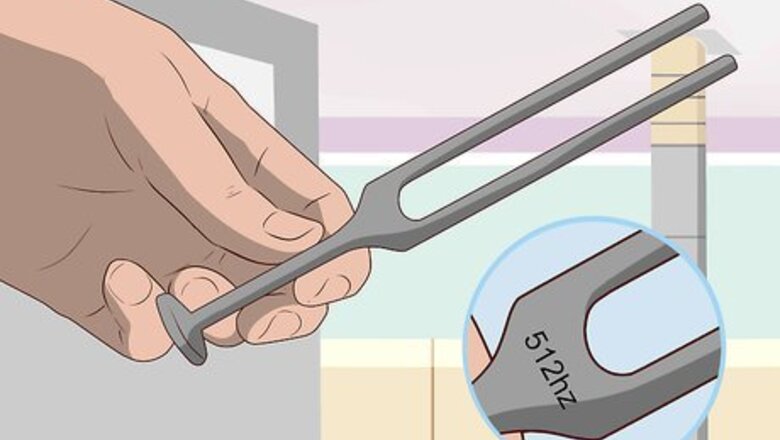
views
Checking for Hearing Loss

Use a 512hz tuning fork. While there are many types of tuning forks available, the 512hz pitch is standard for hearing tests. Purchase one from a medical supply store or website.
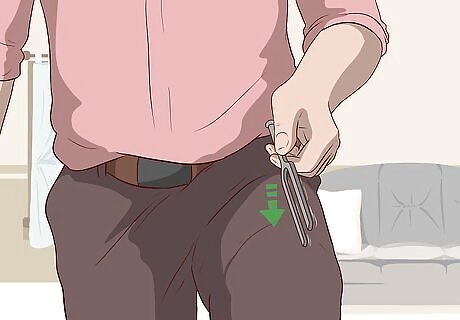
Vibrate the tuning fork. Use two fingers and hold the tuning fork by its base. The two prongs should be facing up. Then tap the two-pronged side against your knee or hand. The prongs will begin vibrating. Don't hit the fork against a table or something else that's hard. This could break the prongs.

Press the tuning fork base directly on the midline on top of the head. You will hear the sound from the tuning fork in your head. If you are doing the test on yourself, see which side you hear the sound stronger on. If you are doing the test on someone else, ask them which side they hear the loudest. This test indicates which ear has better hearing. If there is no noticeable difference in the sound, then both ears hear relatively the same.
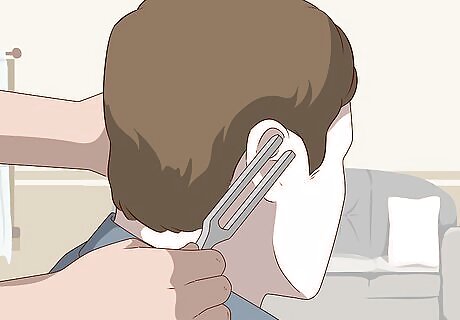
Slide the tuning fork towards the side where you hear the sound less. Without taking the tuning fork off the head or stopping its vibration, slide it towards the weaker side. This tests how severe hearing loss is in that side. The closer you get, the weaker your hearing from that ear is. If you suspect you may be suffering from hearing loss, make an appointment with your doctor as soon as possible.
Tuning Instrument Strings by Ear
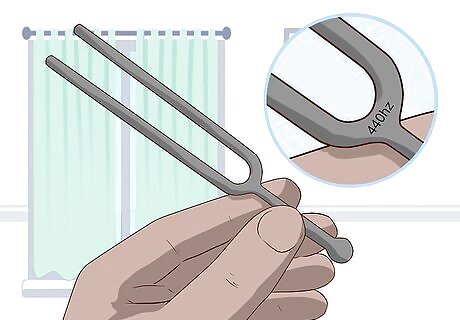
Get a tuning fork with a 440hz pitch. This pitch produces an A note when you strike the tuning fork. It is the most common tuning fork type because it works with all stringed instruments in standard tuning. Whether you play violin, cello, guitar, or bass guitar, an A tuning fork covers the necessary frequencies. There are some other types of tuning forks, but they aren’t as versatile as an A fork. An E tuning fork would work for a guitar or bass guitar, for example, but wouldn’t work for a higher-tuned instrument like a violin.
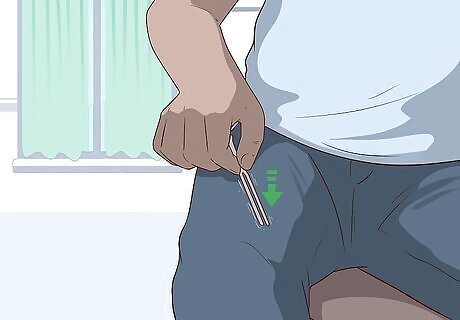
Hit the tuning fork against your knee. Hold the tuning fork by its stem so the two prongs are facing up. Then hit the pronged portion against your knee or something else that’s firm. This makes the fork vibrate and produce a pitch. Hitting the fork against something soft like your knee is best. If you hit it against a table or something else that’s hard, the fork could produce a different note and your tuning will be off. You could also break the tuner if you hit it against something hard.

Press the base of the fork against the instrument body. When you hold the fork against something solid, the sound resonates and produces an A note. Pressing the fork against your instrument works well because the instrument’s natural acoustics amplify the note. You can also hold the fork up to your ear to hear the note, if you’re concerned about the fork scratching your instrument. This will also work with an electric instrument, although the note won’t be as loud.
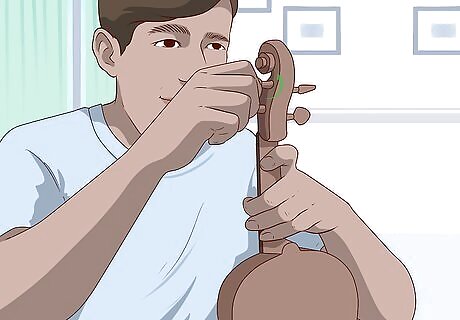
Tune your A string to the note that you hear. Since the tuning fork produces an A note, you now have a reference for tuning the A string. Pluck the A string and see how it compares to the tuning fork note. Tighten the string if the note sounds too flat (or low) and loosen the string if the note sounds too sharp (high). Continue tapping the fork to check your tuning, and stop when the two notes match each other. If you use a tuning fork with a different pitch, tune the correct string to that note. For instance, if you use an E tuning fork with a guitar, tune the E strings to that note.
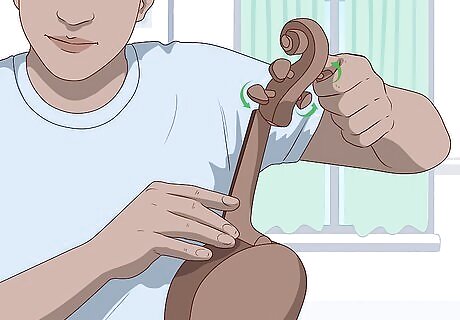
Tune the rest of your strings in relation to the A string. With the A string in tune, you can now tune the rest of the strings by ear. Most stringed instruments in standard tuning are tuned in fifths, meaning that the strings are 5 notes apart. Playing the 5th fret of a string produces the same note as the string above it. Use your A string as a reference to tune the rest of the instrument. All instruments are stringed differently and have a different process for tuning by ear. To tune a guitar by ear, for example, you can use the A string to find the pitch for the D string, the string above it. The A string is the 5th string. If you press the 5th fret of the A string, it produces a D note. Since the D string is the next string above the A, it should produce the same note as the A string, 5th fret. Tune the D string until it sounds the same as the A string, 5th fret. Then use the 5th fret of the D string to find the pitch for the G string, and continue the process for the rest of the guitar. Violins, cellos, and other stringed instruments have similar relations between their strings.
Resonating the Tuner over the Strings
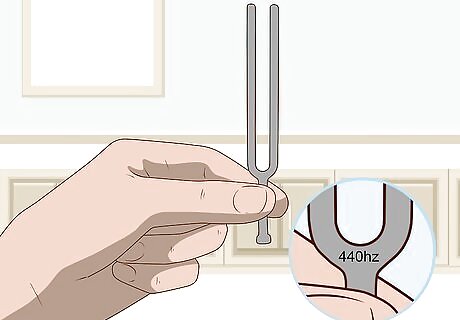
Get a tuning fork that produces an A note. This rings with a 440hz pitch, or a standard A note. An A tuning fork is the most common because it works with all stringed instruments in standard tuning. No matter what you play, you can use an A tuning fork to tune the instrument. There are other types of tuning forks, but they aren’t as versatile and they don’t work on all instruments. For example, an E tuning fork would work with a guitar, but not with a violin.

Find the A note on each string of your instrument. If you have an A tuning fork, that fork will resonate over the A notes on your instrument. Each string on the instrument has at least one A note. Their exact location depends on your instrument. Find the A notes before moving on. On a guitar, for example, the A notes are 5th fret on the E string, 12th fret on the A string, 7th fret on the D string, 2nd fret on the G string, and 10th fret on the B string. When the guitar is in tune, the tuning fork should resonate over these frets. Frets are the metal dividers on the neck of the instrument. The numbers go up starting from the end of the neck. So the fret nearest to the head of the instrument is the 1st fret. If you have a different tuning fork, find the notes that correspond with that fork instead.
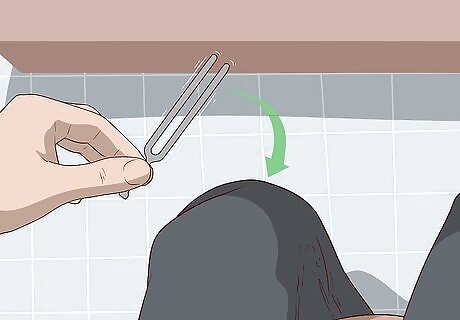
Hit the tuning fork against your knee. Use two fingers and grab the tuning fork by its stem so the two prongs are facing up. Then hit the pronged portion against your knee. This vibrates the fork and produces a pitch. You can hit the fork against something else besides your knee, but it should be something soft. If you hit it against something hard like the table, the fork could produce a different note and your tuning will be off. You could also break the tuner if you hit it against something hard.
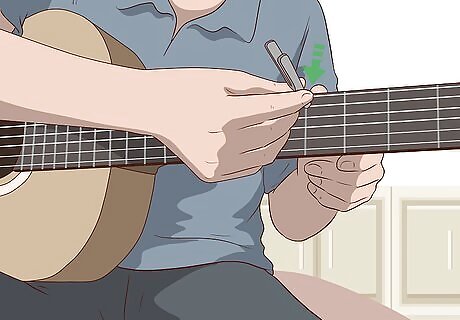
Press the base of the tuner against the A note location on each string. The tuning fork will resonate perfectly over the A note on each string. While the fork is vibrating, press it to the string where the A note should be. If the note plays clearly, the string is in tune. If the sound is weak or doesn’t play, the string is out of tune. On a guitar, for example, the A note on the E string is over the 5th fret. Press the fork directly over this fret. If it rings clearly, the string is in tune. If your instrument is fretless, you’ll have to know the exact location for each note. If you don’t know this, use the previous method to tune by ear.
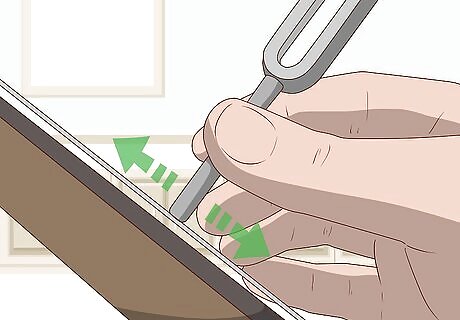
Find the A note if the fork doesn’t resonate in the right location. If the fork doesn’t ring clearly where the A note is supposed to be, that means the string is out of tune and the A note is somewhere else on the string. Keep the fork pressed against the string and move it backwards and forwards from the first place you pressed it. The fork should vibrate louder as you approach the A note. It will resonate loudest when it reaches the A. If the fork stops vibrating before you find the note, hit it against your knee again.
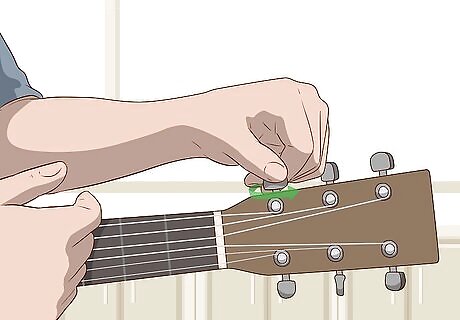
Tighten or loosen the string depending on where the A note is. The location of the A note will tell you if the string is too sharp (high) or flat (low). If the A is higher up on the string than it should be, the string is too loose. Tighten the string to tune it. If the A is lower than it should be, the string it too tight. Loosen it to tune the string.
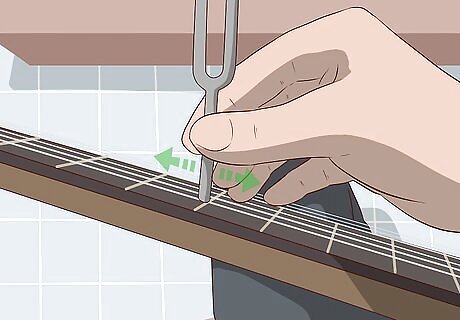
Check to make sure the A note is in the correct spot. After adjusting the string, check the A note location again. If the tuning fork resonates in the right spot, the string is in tune. If it is still slightly off, continue adjusting the string until the fork resonates in the right spot. Repeat this process for each string to tune the whole instrument.
Detecting Broken Bones with a Tuning Fork
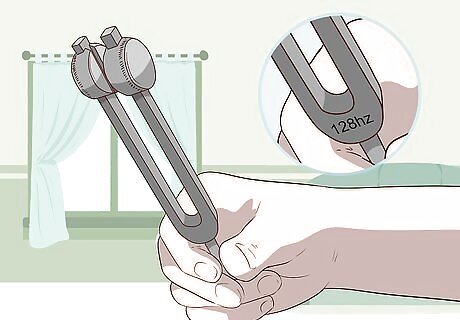
Use a tuning fork with a 128hz pitch. If you suspect a broken bone, this pitch is considered ideal. This type of tuning fork is rare in a musical setting, so you'll have to buy one from a medical supply store or website.
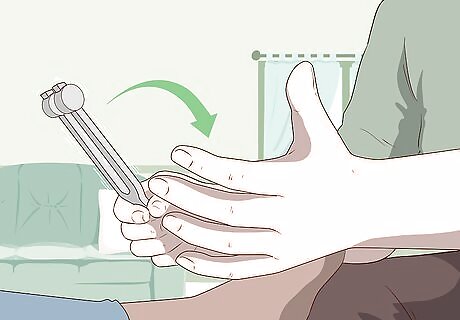
Vibrate the tuning fork. Hold the tuning fork by its base and tap the two-pronged side against your knee or hand. The prongs should begin vibrating and produce a pitch. Don't hit the fork against something hard like a table. This could break the prongs.
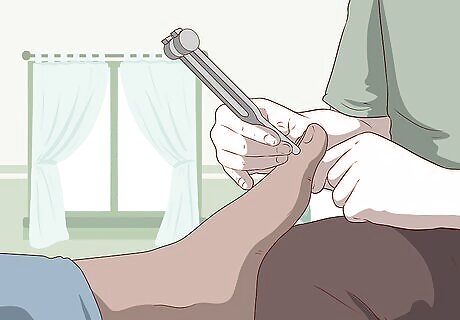
Press the base of the fork against the injury site and see if there is pain. If there is a broken bone underneath where you press the tuning fork, its vibrations will vibrate the bone sections and cause pain. Pain from a broken bone is usually sharp and concentrated in one location. If you feel this type of pain, it indicates a broken bone. Do not press hard with the fork, because this can also hurt you or the patient. Just press lightly and allow the vibrations to enter the body. Retry the test in several areas around the injury site to see if different spots are in pain.
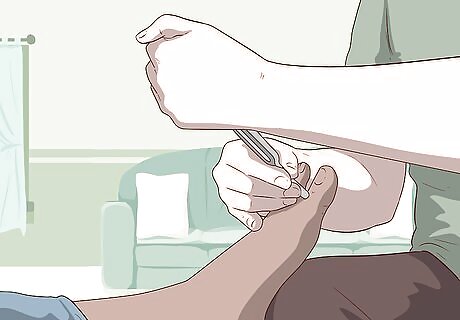
Stop the vibration with your hand too see if the pain remains. Initial pain from the tuning fork test can be a false positive. It could be from pressing the tuning fork too hard against the injury. Test this possibility by leaving the fork pressed against the injury site and touching the prongs with your other hand. This stops the vibration. If you still feel pain after the vibrations stop, you are pressing the tuning fork down too hard. Repeat the pain test by pressing the tuning fork down more lightly. If there is still sharp pain while the fork is vibrating, it indicates a broken bone.
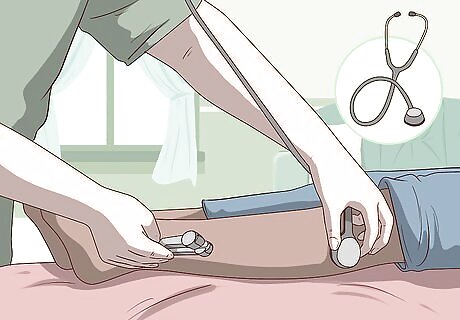
Check the sound produced on larger bones with a stethoscope. The pain test is sometimes unreliable because people have different pain tolerances. A more accurate test uses sound, but it only works on larger bones like those in the leg and arm, and requires a stethoscope. First strike the tuning fork to vibrate it, then press it against the end of the injured bone. Hold it in place for 6-8 seconds. Then press the stethoscope against the other end of the bone. If you hear a clear sound, the bone probably isn't broken. If you hear a weak sound or no sound at all, it indicates the bone is broken. For reference, check the corresponding bone on the other side. If the sound rings louder, it indicates that the first bone is broken.

Follow up with a doctor after this test. Whether or not this test indicates a broken bone, you should still make an appointment with your doctor if you suspect you have an injury. This test is only a guideline, and only an imaging test like an x-ray or MRI can accurately diagnose a fracture.




















Comments
0 comment